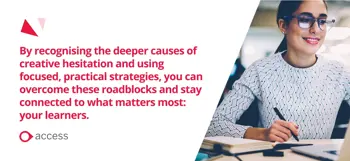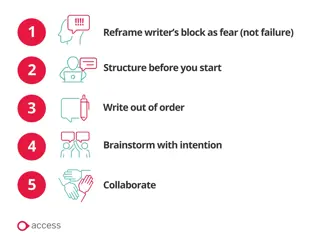5 strategies to beat writer’s block when creating eLearning content
Crafting compelling eLearning content takes creativity, strategy, and clarity - but even the most experienced learning content designers hit a wall from time to time. What we often call writer’s block is rarely about a lack of ideas.
In the Access Learning team, we know that effective learning experiences are built on clear, confident communication. That’s why overcoming creative hesitation is just as important as knowing your subject matter.
Read on for five practical, experience-based tips for writer’s block—specifically designed for eLearning professionals.
1. Reframe writer’s block as fear (not failure)
One of the most common ways to help writer’s block is to shift your mindset. Writer’s block often stems from the pressure to be perfect. When developing eLearning materials, it’s easy to feel overwhelmed by the desire to make every module original, engaging, and impactful - especially when you’re covering topics that have been taught countless times.
But remember: your perspective is unique. The same content can take on new meaning through your lens, shaped by your teaching style, industry experience, and understanding of your learners' needs. Don’t aim for perfection on the first try - aim to start. You can’t refine what hasn’t been written. Give yourself permission to draft freely and edit later.
Ask yourself: Am I truly stuck, or am I afraid of creating something imperfect?
2. Structure before you start
One of the most effective ways to combat writer’s block in instructional design is to outline your course structure before diving into the details. Break down your content into modules, lessons, and key learning objectives. Use a storyboard or mind map to visualise the flow.
This not only makes the task feel more manageable but also helps spark ideas for interactive elements, assessments, and multimedia integration.

3. Write out of order
One of the most underrated techniques for overcoming creative blocks is giving yourself permission to write out of order. There’s no rule that says you have to start your eLearning course with the introduction. In fact, trying to write the “perfect opening” can often stall your momentum before you’ve even begun.
Instead, start with the section you feel most confident about—whether it’s a case study, assessment section, interactive segment, or even a concluding summary. This approach allows you to build momentum by leaning into areas where your ideas are already clear. As you gain traction, you'll often find that the harder sections begin to come together far more easily.
4. Brainstorm with intention
Struggling to come up with ideas? Targeted brainstorming can be a powerful way to help with writer’s block, especially during eLearning development. Instead of waiting for creativity to kick in, guide your thinking with a clear purpose.
Start by focusing on your learners and asking:
- What are their biggest challenges or pain points?
- What common misconceptions need to be addressed?
- How will your course solve a real problem or drive real-world outcomes?
This learner-first approach not only gets ideas flowing, but also ensures your content stays relevant and impactful.
5. Collaborate to refresh your perspective
Collaboration is one of the most effective ways to help with writer’s block. Sometimes, simply discussing your ideas with peers can provide fresh perspectives and new energy. Peer feedback is invaluable in eLearning—another educator, designer, or SME (subject matter expert) might offer insights you hadn’t considered.
Run your ideas by a colleague or another eLearning content creator. Ask them what resonates, what’s unclear, or how they might teach the concept differently.

Final thoughts on beating writer’s block in eLearning
By recognising the deeper causes of creative hesitation and using focused, practical strategies, you can overcome these roadblocks and stay connected to what matters most: your learners.
Whether it’s brainstorming with purpose, structuring before writing, or simply giving yourself permission to write imperfectly, each technique helps bring clarity back to your course design.
Our comprehensive catalogue of eLearning courses covers key topics to help your organisation achieve compliance and drive performance. This includes:
Experience expert-crafted eLearning
Our CPD-certified library covers compliance, health and safety, cyber security, and professional development with RoSPA-assured content designed to engage learners and meet regulatory standards.

 AU & NZ
AU & NZ
 SG
SG
 MY
MY
 US
US
 IE
IE

